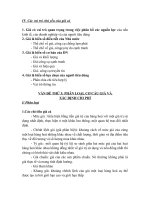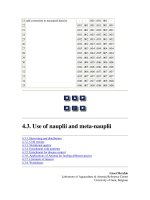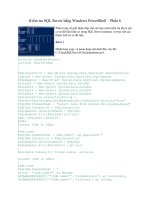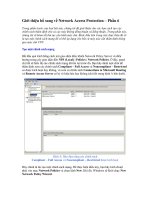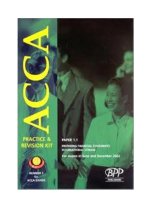Preparing Financial Statements phần 6 docx
Bạn đang xem bản rút gọn của tài liệu. Xem và tải ngay bản đầy đủ của tài liệu tại đây (421.7 KB, 12 trang )
43
Study Period 20 continued
10 The following information is available for the year ended 31 December 19X9 for M. Ski Co,
a well-run company:
$
Opening cash 1,000
Closing cash 2,000
Opening balance on the payables' control account
8,000
Closing balance on the payables' control account 10,000
Opening balance on the receivables' control account 12,000
Closing balance on the receivables' control account 14,000
Cash paid to payables in the period 9,000
Opening inventory 6,000
Closing inventory 7,000
Mark up on Cost – 10%
Assuming the information above is complete, what was the cash introduced or drawings
during the period?
A $2,000
B $1,000
C $5,000
D $6,000
You will find the solutions to this test at the end of this Study Programme. If you answer more
than 5 questions correctly, your performance is satisfactory; if you answer more than 7 correctly,
you are doing very well.
You are now ready to attempt the first course exam. These exams are designed to give you
some question practice at an early stage in your studies to enable you to obtain feedback
on exam technique. Don’t worry too much if you have to revert to the material when
answering questions. Obviously it will be beneficial to attempt them without reference to
your Study Text and notes, but it is the technique in producing answers that is the
valuable element at this stage.
Once you have completed your attempt send your solutions, together with the front sheet,
to:
Marking Department
BPP Professional Education
Aldine House
Aldine Place
142 – 144 Uxbridge Road
Shepherds Bush Green
London W12 8AW
44
Study Period 21
Partnership accounts
Priority = Medium Examined: 6/05
Date due:
Exam Guidance
A note to the latest syllabus states that questions on partnership income statements may
include the effects of the admission and the retirement of partners on the profit-sharing
arrangements.
This is a fairly straightforward procedure. Assuming that profits accrue evenly throughout the
year, the profits for the year are dealt with in two sections. The profits up to the date of
admission/retirement are apportioned according to the old profit-sharing ratio and the profits
after that date are apportioned in the new profit-sharing ratio.
Try questions 3 and 4 in progress test 3.
Guidance through the Study Text
These topics are covered in Chapter 18 Partnership accounts.
Section Approach Essential points
1
The characteristics
of partnerships
Read through this carefully.
Differences between partnerships and
sole traders and limited liability
companies
2
Preparing
partnership accounts
Pay particular attention to
this section.
Use of the appropriation account;
current and capital accounts
Try Question 25 and 26 in the Exam Question Bank of your Study Text
Exam focus point
There were 2 MCQs on partnership accounts in the June 2005 exam.
45
Study Period 21 continued
Were you awake?
If you've been concentrating, you should be able to answer some key questions.
How does the proprietors' section of the balance sheet differ for partnerships?
What goes into the capital and current accounts for each partner?
What goes into the appropriation account?
How do you account for a guaranteed minimum profit share?
Any problems?
Email (accaqueries @bpp.com) fax (020 8740 2293) or phone us (020 8740 2242/2245)
Learning Resource Centre
What do you want to do? How to do it! Reference
Test your knowledge BPP i-Pass *
Session 6: Limited liability
companies and partnerships
Learn interactively BPP i-Learn/BPP Virtual Campus Module 7
Improve your study skills
BPP's Learning to Learn
Accountancy book *
* Included within your Home Study course
If you want any of these products, visit:
www.bpp.com/acca
Common Pitfalls
• Confusion between partners' current and capital accounts and what goes into
each
• Not practising partnership questions
46
Study Period 22
Cash flow statements
Priority = High Examined: 6/05
Date due:
Exam Guidance
Cash flow statements can form an entire question or part of a discursive question. It is
important that you are able to discuss the need for cash flow statements and the advantages and
disadvantages, in addition to being able to perform calculations.
Guidance through the Study Text
These topics are covered in Chapter 20 Cash flow statements.
Section Approach Essential points
1
IAS 7 Cash flow
statements
Read through this section carefully.
Layout of the cash flow
statement and notes
2
Preparing a cash
flow statement
Work through this very thoroughly.
Learn the step by step
method of preparation
Try Question 27, 28 and 29 in the Exam Question Bank of your Study Text
Exam focus point
The June 2005 exam had an 11 mark question on preparing a company cash flow.
47
Study Period 22 continued
Were you awake?
If you've been concentrating, you should be able to answer some key questions.
Why are cash flow statements needed?
List the different categories of cash flow and what goes into each.
What are the advantages of cash flow accounting?
What are the disadvantages of cash flow accounting?
Any problems?
Email (accaqueries @bpp.com) fax (020 8740 2293) or phone us (020 8740 2242/2245)
Learning Resource Centre
What do you want to do? How to do it! Reference
Test your knowledge BPP i-Pass *
Session 9: Cash flow
statements
Learn interactively BPP i-Learn/BPP Virtual Campus Module 12
Improve your study skills
BPP's Learning to Learn
Accountancy book *
* Included within your Home Study course
If you want any of these products, visit:
www.bpp.com/acca
Common Pitfalls
• Failure to learn the layout
• Not using workings to calculate figures – it is important to use workings if your
answer is to be clear and properly laid out
• Incorrect workings for non-current assets. If you are given figures for opening
and closing assets at cost and opening and closing accumulated depreciation you
must use two T accounts (cost a/c and provision for depreciation a/c). If you are
only given the opening and closing net book value then just use one T account
(NBV a/c) to record all non-current asset movements
48
Study Periods 23 & 24
Interpretation of financial statements
Priority = High Examined: 6/05
Date due:
Exam Guidance
The examiner will be looking to see whether you understand and can interpret the figures as
well as being able to calculate them.
Two study periods have been scheduled for this section.
Guidance through the Study Text
These topics are covered in Chapter 22 Interpretation of financial statements.
Section Approach Essential points
1
The broad
categories of
ratios
Read through quickly.
2 – 5
Pay particular attention to these, as
ratios are always examined.
Learn the different ratios and the
format of a ratio analysis report
Try Question 32 and 38 in the Exam Question Bank of your Study Text
Exam focus point
The June 2005 exam had a 9 mark question on interpretation of accounts.
49
Study Periods 23 & 24 continued
Were you awake?
If you've been concentrating, you should be able to answer some key questions.
Give two ratios that measure profitability and return.
How do you calculate earnings per share?
What does gearing measure?
Give two ratios that interpret movements in working capital.
Any problems?
Email (accaqueries @bpp.com) fax (020 8740 2293) or phone us (020 8740 2242/2245)
Learning Resource Centre
What do you want to do? How to do it! Reference
Test your knowledge BPP i-Pass *
Session 10: Interpreting
company accounts
Learn interactively BPP i-Learn/BPP Virtual Campus Module 13
Improve your study skills
BPP's Learning to Learn
Accountancy book *
* Included within your Home Study course
If you want any of these products, visit:
www.bpp.com/acca
Common Pitfalls
• Failing to learn the formulae
• Making no comments on the ratios, or totally inappropriate ones. Sensible
comments should get you marks – please do not use words like 'bad', 'good' etc
50
Study Period 25
The IASB and financial reporting
Priority = Medium
Date due:
Exam Guidance
This area could be examined in a discursive question. The examiner’s initial guidance
indicates that you should be able to discuss the different methods of accounting for changes in
price levels and that questions will not be set requiring detailed calculations.
Because of the transition to IFRSs on 1 January 2005, the IASB and convergence issues are
very topical. Note the new IFRS 1.
Guidance through the Study Text
These topics are covered in Chapter 24 The IASB and financial reporting.
Section Approach Essential points
All
Read through quickly to obtain an
overview of this chapter.
Understand the differences between
historical cost and current value
Try Question 33 and 34 in the Exam Question Bank of your Study Text.
Exam focus point
The December 2003 exam had a 9-mark discussion question on historical cost accounting.
51
Study Period 25 continued
Were you awake?
If you've been concentrating, you should be able to answer some key questions.
What are the differences between historic cost and current value accounting?
What are the limitations of financial accounting?
What are the criticisms of the accruals concept?
What is the meaning of GAAP?
Any problems?
Email (accaqueries @bpp.com) fax (020 8740 2293) or phone us (020 8740 2242/2245)
Learning Resource Centre
What do you want to do? How to do it! Reference
Test your knowledge BPP i-Pass *
Session 11: Reporting
financial performance
Learn interactively BPP i-Learn/BPP Virtual Campus Module 14
Improve your study skills
BPP's Learning to Learn
Accountancy book *
* Included within your Home Study course
If you want any of these products, visit:
www.bpp.com/acca
Common Pitfall
• Ignoring this chapter – the examiner likes discursive type questions
52
Study Period 26
Group accounts
Priority = High Examined: 6/05
Date due:
Exam Guidance
This could be a key discursive exam area on the question of consolidations. However you are
more likely to be asked to calculate an item on the consolidated balance sheet eg consolidated
reserves or minority interest.
Note that goodwill is no longer amortised. It is now kept in the balance sheet subject to annual
impairment reviews. You are sure to need to know this!
Guidance through the Study Text
These topics are covered in Chapter 21 Group accounts.
Section Approach Essential points
All
Pay particular attention to all sections.
This is a very important chapter.
Learn the definitions and when there is
exclusion or exemption from group
accounts
Know how to calculate minority interests
and all items in the consolidated balance
sheet
Try Questions 30 and 31 in the Exam Question Bank of your Study
Text
Exam focus point
The June 2005 exam had 3 MCQs on group accounts.
53
Study Period 26 continued
Were you awake?
If you've been concentrating, you should be able to answer some key questions.
When can a subsidiary be excluded from group accounts?
How do you calculate minority interests in the consolidated balance sheet?
What are the entries for goodwill arising on consolidation?
Why should entities prepare group accounts?
Any problems?
Email (accaqueries @bpp.com) fax (020 8740 2293) or phone us (020 8740 2242/2245)
Learning Resource Centre
What do you want to do? How to do it! Reference
Test your knowledge BPP i-Pass *
Session 12: Group
accounting
Learn interactively BPP i-Learn/BPP Virtual Campus Module 15
Improve your study skills
BPP's Learning to Learn
Accountancy book *
* Included within your Home Study course
If you want any of these products, visit:
www.bpp.com/acca
Common Pitfalls
• Not learning the definitions in Section 1
• Not practising enough questions
• Underestimating the importance of group accounts
54
Study Period 27
Progress Test 3
Priority = High
Date due:
In order to reinforce what you have learnt in the study periods, answer the following multiple
choice questions without referring to your study text or notes. You should then revise any areas
with which you had difficulty.
1 The draft accounts of Turner Co for the year ended 31 December 19X9 include the
following:
Sales revenue $80,000
Gross profit $20,000
It was subsequently discovered that sales revenue had been understated by $10,000 and
closing inventory overstated by $5,000. After correction of these errors the gross profit
percentage will be:
A 33.3%
B 16.7%
C 31.3%
D 27.8%
2 You are given the following information regarding Elva Co as at 31 December 19X9:
$
Receivables 22,000
Inventories 9,000
Short term investments 6,000
Trade payables 8,000
Bank overdraft 5,000
10% loan stock 20X6 10,000
Income tax payable 7,000
What is the acid test ratio?
A 1.4:1
B 1.85:1
C 1.12:1
D 1.23:1
